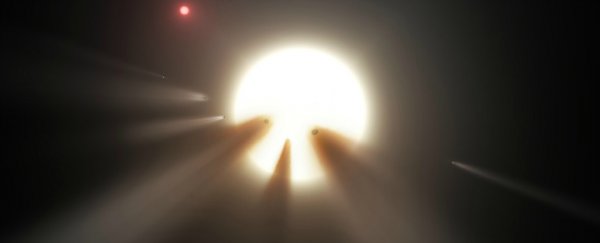A team of astronomers has successfully crowdfunded a year's worth of observatory time to investigate the hypothesised 'alien megastructure' orbiting a mysterious star called KIC 8462852.
The team raised over US$100,000 in under a month for the study, and they hope it will buy them enough time to conclude once and for all what's causing KIC 8462852's light to dim in ways scientists have never seen before.
In case you've missed the controversy surrounding KIC 8462852 - an F-type star that lies 1,480 light-years away - here's a quick rundown.
The story began in 2015, when Yale astronomer Tabetha Boyajian led a team of citizen scientists called the Planet Hunters in examining data collected by the Kepler space telescope.
KIC 8462852 - now nicknamed Tabby's Star after Boyajian - was just one star out of hundreds that Kepler marked as abnormal after studying the night sky using the transit method. Astronomers use this method to identify exoplanet candidates by watching a star's light until it flickers or dims as an exoplanet crosses in front of it.
During their analysis, things got weird. Normally, when Kepler spies a possible exoplanet using the transit method, the suspected star's light only dims by about 1 percent, but Tabby's Star dimmed by a remarkable 22 percent, and stayed that way for up to 80 days at a time.
Despite the lack of evidence, many hypotheses abound about the structure, including a massive comet swarm, which was quickly debunked.
One of the most intriguing ideas is that it could be a Dyson sphere - a hypothetical structure described in several science fiction stories that works like a giant solar panel, used by an advanced civilisation to collect energy from its host star. While there's obviously no proof that such technology exists, it's pretty cool to think about.
"Aliens should always be the very last hypothesis you consider, but this looked like something you would expect an alien civilisation to build," Jason Wright, an astronomer from Penn State University in the US, told The Atlantic last year.
Since this discovery, no one's been able to come up with an explanation that can't be adequately debunked. But now, thanks to the successful Kickstarter campaign, Boyajian and her team hope to figure it all out.
"Our initial requested funds will cover all expenses for one year of monitoring the star. This will include a total of 2 hours per night dedicated to observing it," the team announced. "Observations will be dispersed for even temporal coverage throughout the night, and each pointing will cycle through a set of filters to give us the brightness at a range of colours."
To do so, the researchers will use the Las Cumbres Observatory Global Telescope Network (LCOGT), which is a privately owned series of telescopes that can monitor a single object for a long period of time, just like Kepler does at a higher level of detail.
While the folks who run LCOGT have already gifted 200 hours to the project (who doesn't want to be part of possibly finding aliens?), this amount of time is only enough to get the team through the end of summer in the US. With the funds raised on Kickstarter, the team now has the ability to continue their mission for another 12 months.
It's important to remember that this sort of study takes a lot of time and no one can say - especially this early on - if they will actually find anything even remotely conclusive. But there's also the chance that they will, which is super exciting, because we've never seen anything like this star before.
The Planet Hunters aren't the only group examining Tabby's Star. A report issued in November 2015 by researchers from the Search for Extraterrestrial Intelligence Institute (SETI) concluded that no signs of intelligent life - in the form of radio waves - had been detected in the star's region.
Still, many are holding on to the hope that some sort of structure is present, but only time will tell (hopefully).

